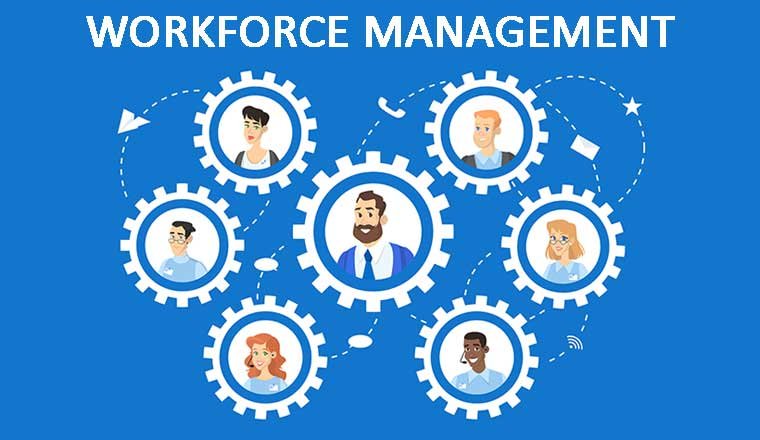Are you looking to reduce costs, increase productivity, automate processes and boost team morale? Turns out that many organizations have been searching for this unicorn of a solution, and many have found it by embracing workforce management (WFM).
Workforce management is a set of strategies designed to allocate resources, improve efficiency, forecast workloads and manage schedules. Here’s everything you need to know about Workforce Management.
What Is Workforce Management?
Workforce management is a set of processes employers use to direct staff members to be in the right places at the right times in order to reduce risks and maximize productivity. It’s a top-down approach that starts with leadership creating defined strategic goals so that businesses have clear direction as to how decisions will be made in the near future.
The concept of work force management originally began in call center environments in the mid 1980s as a way to boost up consistency and efficiency in organizations , and has since expanded into a wide variety of industries. Businesses implement workforce management to help improve time management, predict workloads, offer analytical insights and expedite the employee scheduling process.
How Do Workforce Management Work?
The most efficient workforce management system is one that finds the maximum fit between the amount of work required and the amount of staff needed to handle that work task. Building an effective system takes time, so don’t expect results overnight. Most companies must follow a series of steps when implementing a workforce management strategy:
- Standardize Procedures: Once the right workforce management solutions are in place, create standardized procedures for the entire workforce.
- Monitor Progress: As objectives change, workforce management systems will as well, so be prepared to monitor progress, assess performances and make adjustments when needed.
- Implement Automation: Adding automation wherever possible, means a more streamlined workforce management process that will maximize productivity and reduce costs over time.
- Analysis: By gathering data and auditing the current workforce, businesses are able to create where there are overlaps and gaps in processes.
- Strategic Direction: Leadership sets both short- and long-term objectives, then figures out how the workforce needs to be aligned to meet those goals or achievements.
- Identify Solutions: There are all sorts of tools and software that can be used to apply workforce management principles, and choosing the best ones will ultimately depend on both the current workforce and future objectives.
Benefits of Workforce Management
Once an effective workforce management system is in place, organizations will begin reaping the advantages almost instantaneous. The biggest and fastest advantage will be an increase in productivity, as many time-wasting activities will be either shot off or eliminated totally. Automation will lead to less errors, improved safety and more consistent production. And more streamlined processes means a lighter workload, resulting in boosted morale and delighted employees.
Major Aspects of Successful Workforce Management
Since every company is unique, each workforce management technique needs to be unique as well. Because of different goals, requirements and demographics, there is not a one-size-fits-all, cookie-cutter approach. But no matter the industry, there are several key aspects to every successful workforce management strategy:
- Payroll and Benefits: Many workforce management software packages have the ability to create custom reports that provide information about payroll administration, employee advantages and fiscal year data needed for taxes.
- Time Management and Scheduling: Tracking employee hours is one of the most essential aspects of workforce management. Having a scheduling system in place allows for maximum time management and productivity, along with more streamlined delegation.
- Predicting and Budgeting: Using workforce management to analyze past and present often provides valuable insight into both business and team operations. This information can be used to predict future trends and budget appropriately for expenses such as labor costs.
- Data Reporting and Analytics: Workforce management metrics are indicators that expose the efficiency and effectiveness of onboarding, training and proficiency. It offers a way to measure the effectiveness of teams, as well as illustrate areas that need improvement.
- Recruiting and Applicant Tracking: An effective and efficient workforce management program will help human resources departments be better equipped to recruit the right employees for the right areas.
Workforce management can identify the needs of every department, match skills with positions, recruit team members and retain employees. - Compliance and Mitigating Risk: Reducing risk and staying compliant are essential components for any organization, and are often time consuming undertakings. Using workforce management tools to organize, maximize and track crucial information allows organizations to stay on top of essential compliance measures.
Conclusion
Workforce management is crucial because it helps implement a framework for effective scheduling, predicting and budgeting in order for organizations to effectively run their operations and tasks. Through the use of automation and other tools, businesses are able to plan and meet strategic goals, while also improving efficiency. The result of finding and implementing the right workforce management system for your industry is a happy, responsive workforce that is performing as optimally as possible.

Leave a Reply